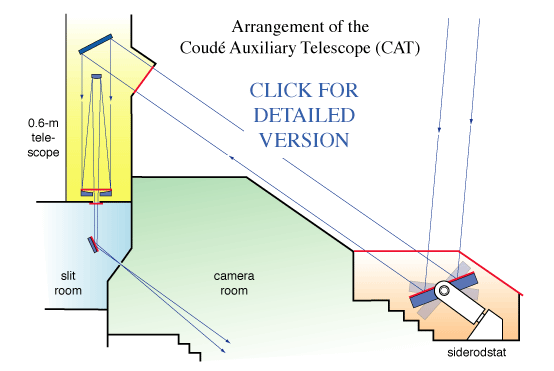
Description of the Telescope
The CAT consists of a flat, equatorially mounted siderostat mirror housed under a retractable-roof shed attached to the south wall of the 120-inch's dome, and a fixed, 24-inch, f36 cassegrain telescope mounted vertically just inside the dome's south wall, above the spectrograph's entrance slit. The lightpath and major parts of the telescope are illustrated below. The diagram is not to scale and the siderostat shed is not shown.
The CAT has five reflections (six when used with the image rotator). The mirrors are numbered one through five in order of occurence along the lightpath. Starlight is reflected from the siderostat (mirror #1) which guides it through a shuttered opening in the side of the 120-inch's dome. Just behind the shutter, the beam is reflected downward by the fixed flat (mirror #2) to the primary (mirror #3), back up to the secondary (mirror #4), and back down, through a hole in the center of the primary to the pick-off mirror (mirror #5), located in the slit room. The final reflection from the pick-off mirror directs the beam onto the optical axis of the spectrograph, just above the entrance slit. At this point CAT beam is, from the point of view of the spectrograph, indistinguishable from the 3-meter beam. The beam comes to a focus on the slit and passes into the camera room to one spectrograph itself.
The CAT's view is limited in the north by the dome. This and other pointing limits, as well as wind and humidity limits, are described in the Telescope Limits section of this manual.
The CAT and its associated instruments are, for the most part, remotely operated from a control room in the basement of the dome. Detailed instructions for operating the telescope are given in the following sections:
The Hamilton User's Manual gives complete instructions for using the Hamilton Spectrograph.